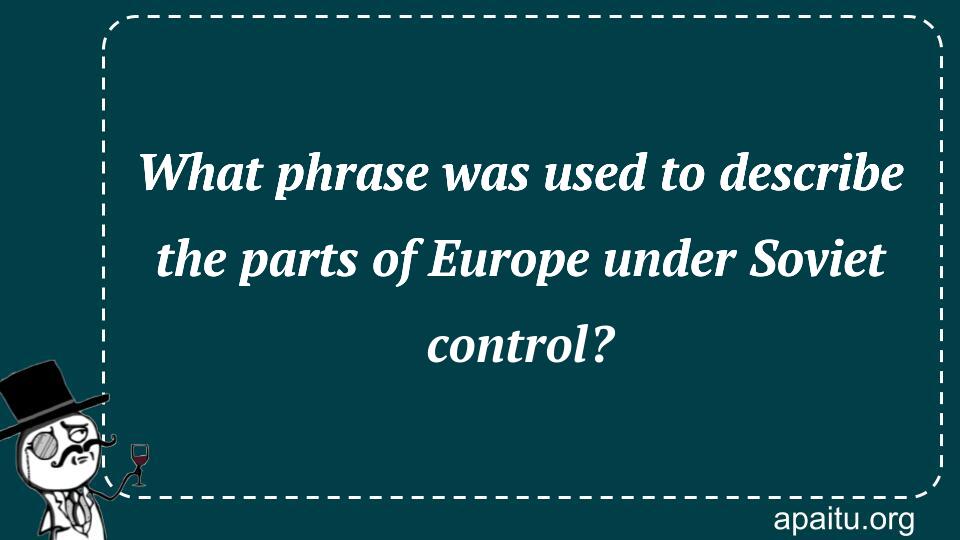Question
Here is the question : WHAT PHRASE WAS USED TO DESCRIBE THE PARTS OF EUROPE UNDER SOVIET CONTROL?
Option
Here is the option for the question :
- Soft underbelly
- Axis of Evil
- Hanseatic League
- Iron Curtain
The Answer:
And, the answer for the the question is :
Explanation:
The Soviet Union employed ideological and physical barriers known as “The Iron Curtain” to isolate itself and its satellite governments from non-communist countries in Western Europe and North America. Following the conclusion of World War II, the Iron Curtain was put in place; it was removed in 1989 with the fall of the Berlin Wall.

The term “Iron Curtain” holds a significant place in history, symbolizing the division between Eastern and Western Europe during the Cold War era. Coined by British Prime Minister Winston Churchill in a speech delivered in 1946, the phrase served as a vivid metaphor for the ideological and physical separation imposed by the Soviet Union on the countries under its control. The Iron Curtain represented not only a physical barrier but also a metaphorical representation of the stark contrast between the Communist East and the democratic West.
Following the end of World War II, Europe found itself in a state of political and ideological turmoil. The victorious Allied powers, including the United States, the Soviet Union, and their respective allies, sought to exert influence and shape the future of the continent. As the Soviet Union consolidated its control over Eastern European countries such as Poland, Hungary, Czechoslovakia, and East Germany, a clear divide emerged between the Communist East and the democratic West.
Winston Churchill’s use of the term “Iron Curtain” in his speech at Westminster College in Fulton, Missouri, on March 5, 1946, brought attention to this division. Churchill warned of the growing influence of the Soviet Union and described the situation as follows: “From Stettin in the Baltic to Trieste in the Adriatic, an iron curtain has descended across the Continent.”
The Iron Curtain represented not only a physical separation but also a manifestation of the contrasting political, economic, and social systems between the East and the West. Behind the Iron Curtain, the Soviet Union and its satellite states established centralized control, implemented Communist ideologies, and restricted personal freedoms. This included censorship, surveillance, and the suppression of dissenting voices. The Eastern Bloc countries became heavily dependent on the Soviet Union, both politically and economically.
On the other side of the Iron Curtain, Western Europe aligned itself with the United States and embraced democratic systems, free markets, and individual liberties. The countries of Western Europe experienced economic recovery, political stability, and the establishment of transnational organizations such as the North Atlantic Treaty Organization (NATO) and the European Economic Community (EEC), which later evolved into the European Union (EU).
The physical barrier of the Iron Curtain was reinforced by various means, including border fortifications, barbed wire fences, minefields, and heavily guarded checkpoints. It effectively limited the movement of people, ideas, and goods between the Eastern and Western parts of Europe. Families and friends were separated, and cultural and intellectual exchanges were severely restricted.
However, the Iron Curtain also sparked resistance and a desire for freedom among those living under Soviet control. The division served to strengthen the resolve of individuals and groups who sought to challenge the Communist regimes and bring about political change. Movements such as the Solidarity movement in Poland and the Velvet Revolution in Czechoslovakia demonstrated the yearning for liberty and the rejection of the oppressive regimes.
The fall of the Iron Curtain began in the late 1980s with a series of significant events, including the reforms implemented by Soviet leader Mikhail Gorbachev and the opening of the Berlin Wall in 1989. These events signaled a shift in the political landscape of Europe, leading to the reunification of Germany and the eventual dissolution of the Soviet Union in 1991.
the term “Iron Curtain” stands as a historical reminder of the division and repression that characterized Europe during the Cold War. It serves as a symbol of the resilience of individuals and the triumph of freedom over oppression. The impact of the Iron Curtain on European history and its lasting legacy continue to shape the collective memory of the continent.
the phrase “Iron Curtain” was used to describe the parts of Europe that fell under Soviet control during the Cold War. Coined by Winston Churchill, the term represented the physical and ideological division between the Communist East and the democratic West. The Iron Curtain symbolized the stark contrast in political systems, economic models, and personal freedoms between the two sides. While it created a barrier that separated families and restricted movement, it also fueled resistance and ultimately crumbled in the face of popular demands for freedom. The Iron Curtain remains an enduring symbol of the challenges and triumphs of the Cold War era in Europe.